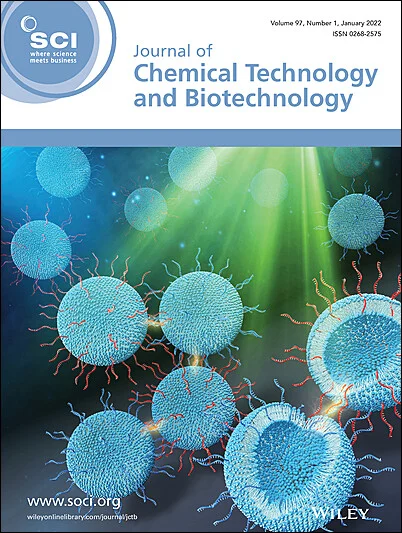Daiane Marques de Oliveira, Ana Caroline Raimundini Aranha, Patricia Hissae Yassue-Cordeiro, Mara Heloisa Neves Olsen Scaliante, Marcos de Souza
求助PDF
{"title":"二氧化钛在丝网上的高效固定化用于强化光催化废水处理","authors":"Daiane Marques de Oliveira, Ana Caroline Raimundini Aranha, Patricia Hissae Yassue-Cordeiro, Mara Heloisa Neves Olsen Scaliante, Marcos de Souza","doi":"10.1002/jctb.7896","DOIUrl":null,"url":null,"abstract":"<div>\n \n \n <section>\n \n <h3> BACKGROUND</h3>\n \n <p>Advanced oxidative processes (AOPs) have emerged as a promising alternative for wastewater treatment, with photocatalysis standing out as a particularly effective approach. The use of titanium dioxide (TiO<sub>2</sub>) as the primary photocatalyst is well-established among researchers, especially in suspension. However, the challenge of separating the catalyst powder from the treated effluent has driven the development of immobilized catalyst systems. Immobilization facilitates catalyst reuse, provided that an adhesion method ensures strong attachment to the support material, preventing catalyst loss during repeated cycles.</p>\n </section>\n \n <section>\n \n <h3> RESULTS AND CONCLUSION</h3>\n \n <p>The study investigated the immobilization of TiO<sub>2</sub> on screens for photocatalytic processes, aiming for improved reuse and pollutant degradation efficiency. The wash-coating method was used to test different supports and drying conditions. The best result was obtained with P25 TiO<sub>2</sub> immobilized on a silk screen and dried at 80 °C for 36 h, ensuring a uniform and adherent coating. Characterization by SEM, EDX, FTIR, and ATR confirmed the catalyst's presence, and the band-gap value was consistent with the literature. The material achieved over 95% methyl orange degradation, with optimal performance at pH 4. Reuse tests showed high stability, maintaining efficiency after five cycles. Comparison with photolysis confirmed that photocatalysis was the primary degradation mechanism. The results highlight the effectiveness of immobilized TiO<sub>2</sub> on silk screens as a low-cost and sustainable alternative for wastewater treatment. © 2025 Society of Chemical Industry (SCI).</p>\n </section>\n </div>","PeriodicalId":15335,"journal":{"name":"Journal of chemical technology and biotechnology","volume":"100 8","pages":"1656-1666"},"PeriodicalIF":2.4000,"publicationDate":"2025-05-20","publicationTypes":"Journal Article","fieldsOfStudy":null,"isOpenAccess":false,"openAccessPdf":"","citationCount":"0","resultStr":"{\"title\":\"Efficient immobilization of TiO2 on silk screens for enhanced photocatalytic wastewater treatment\",\"authors\":\"Daiane Marques de Oliveira, Ana Caroline Raimundini Aranha, Patricia Hissae Yassue-Cordeiro, Mara Heloisa Neves Olsen Scaliante, Marcos de Souza\",\"doi\":\"10.1002/jctb.7896\",\"DOIUrl\":null,\"url\":null,\"abstract\":\"<div>\\n \\n \\n <section>\\n \\n <h3> BACKGROUND</h3>\\n \\n <p>Advanced oxidative processes (AOPs) have emerged as a promising alternative for wastewater treatment, with photocatalysis standing out as a particularly effective approach. The use of titanium dioxide (TiO<sub>2</sub>) as the primary photocatalyst is well-established among researchers, especially in suspension. However, the challenge of separating the catalyst powder from the treated effluent has driven the development of immobilized catalyst systems. Immobilization facilitates catalyst reuse, provided that an adhesion method ensures strong attachment to the support material, preventing catalyst loss during repeated cycles.</p>\\n </section>\\n \\n <section>\\n \\n <h3> RESULTS AND CONCLUSION</h3>\\n \\n <p>The study investigated the immobilization of TiO<sub>2</sub> on screens for photocatalytic processes, aiming for improved reuse and pollutant degradation efficiency. The wash-coating method was used to test different supports and drying conditions. The best result was obtained with P25 TiO<sub>2</sub> immobilized on a silk screen and dried at 80 °C for 36 h, ensuring a uniform and adherent coating. Characterization by SEM, EDX, FTIR, and ATR confirmed the catalyst's presence, and the band-gap value was consistent with the literature. The material achieved over 95% methyl orange degradation, with optimal performance at pH 4. Reuse tests showed high stability, maintaining efficiency after five cycles. Comparison with photolysis confirmed that photocatalysis was the primary degradation mechanism. The results highlight the effectiveness of immobilized TiO<sub>2</sub> on silk screens as a low-cost and sustainable alternative for wastewater treatment. © 2025 Society of Chemical Industry (SCI).</p>\\n </section>\\n </div>\",\"PeriodicalId\":15335,\"journal\":{\"name\":\"Journal of chemical technology and biotechnology\",\"volume\":\"100 8\",\"pages\":\"1656-1666\"},\"PeriodicalIF\":2.4000,\"publicationDate\":\"2025-05-20\",\"publicationTypes\":\"Journal Article\",\"fieldsOfStudy\":null,\"isOpenAccess\":false,\"openAccessPdf\":\"\",\"citationCount\":\"0\",\"resultStr\":null,\"platform\":\"Semanticscholar\",\"paperid\":null,\"PeriodicalName\":\"Journal of chemical technology and biotechnology\",\"FirstCategoryId\":\"5\",\"ListUrlMain\":\"https://scijournals.onlinelibrary.wiley.com/doi/10.1002/jctb.7896\",\"RegionNum\":4,\"RegionCategory\":\"生物学\",\"ArticlePicture\":[],\"TitleCN\":null,\"AbstractTextCN\":null,\"PMCID\":null,\"EPubDate\":\"\",\"PubModel\":\"\",\"JCR\":\"Q3\",\"JCRName\":\"BIOTECHNOLOGY & APPLIED MICROBIOLOGY\",\"Score\":null,\"Total\":0}","platform":"Semanticscholar","paperid":null,"PeriodicalName":"Journal of chemical technology and biotechnology","FirstCategoryId":"5","ListUrlMain":"https://scijournals.onlinelibrary.wiley.com/doi/10.1002/jctb.7896","RegionNum":4,"RegionCategory":"生物学","ArticlePicture":[],"TitleCN":null,"AbstractTextCN":null,"PMCID":null,"EPubDate":"","PubModel":"","JCR":"Q3","JCRName":"BIOTECHNOLOGY & APPLIED MICROBIOLOGY","Score":null,"Total":0}
引用次数: 0
引用
批量引用




 求助内容:
求助内容: 应助结果提醒方式:
应助结果提醒方式:


